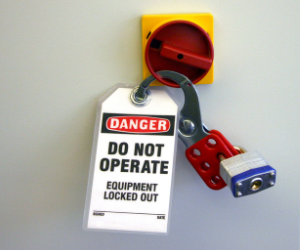OSHA’s Focus on Lockout Tagout Prompts Shift to Digitization
When it comes to workplace health and safety, one of OSHA’s topmost-cited standards is the Control of Hazardous Energy, commonly known as Lockout Tagout (LOTO). The U.S. Department of Labor reported over 1,800 citations between October 2020 and September 2021, amounting to over $12 million in penalties in breach of LOTO standards.
With the increase in enforcement and the dangerous safety issues these violations pose, companies need to shift their focus to better understand their failings with LOTO and how they can improve their process safety practices.
The most common citations with Lockout Tagout
 Lockout-Tagout Common violations often range from as small as preventing cuts caused by food slicers to the proper storage of gas cylinders. Effective Lockout-Tagout is more than a safety policy. It requires specific procedures for specific equipment and assets to ensure that energy sources cannot cause injuries and fatalities. The control of hazardous energy is crucial for the safety of employees, assets and equipment.
Lockout-Tagout Common violations often range from as small as preventing cuts caused by food slicers to the proper storage of gas cylinders. Effective Lockout-Tagout is more than a safety policy. It requires specific procedures for specific equipment and assets to ensure that energy sources cannot cause injuries and fatalities. The control of hazardous energy is crucial for the safety of employees, assets and equipment.
OSHA or any other Occupational Health and Safety agency requires all employers to formalize a LOTO policy, train their employees and put it into practice.
Energy sources that fall under the purview of this regulation vary from electrical and mechanical to hydraulic and chemical, all of which can pose serious risks that could be catastrophic and endanger employees and communities The regulation of both locking out a machine or energy source and tagging it out to ensure that it can do no harm is a necessary protection to prevent employees from serious injuries and death.
According to EHS Today, the most cited violations underneath the umbrella of LOTO are:
- 1910.147(c)(4) Energy control procedure- This code requires employers to develop procedures, document them and utilize them for the control of potentially hazardous energy
- 1910.147(c)(7) Training and communication- The employer is required to provide training to ensure that the purpose and function of the energy control program are understood by employees and that they have acquired the knowledge and skills required for the safe application, usage and removal of the energy controls
- 1910.147(c)(6) Periodic inspection- The employer is responsible for conducting a periodic inspection of the energy control procedure to ensure that the requirements are being followed
LOTO as a part of Environment, Health and Safety (EHS) programs
These three common citations point to a general failure of companies to take safety seriously. While speaking on the ten most-cited violations at the National Safety Council 2019 Congress & Expo, Patrick Kapust, deputy director of OSHA’s Directorate of Enforcement Programs, made the agency’s position clear:
“These are common violations that we’re finding—they’ve been in place for a lot of years,” Kapust said. “The answers are out there, and employers shouldn’t feel like these are very complex issues.”
The lack of a proper LOTO procedure, employee training and failure to inspect if procedures are being followed correctly will inevitably result in significant pressure and fines from OSHA. Combined with this, OSHA estimates that companies pay almost $1 billion per week for direct workers’ compensation costs alone. Investing in prevention methods and enhanced safety procedures is necessary for OSHA compliance and equally important for the company’s success.
Modernizing LOTO compliance
Proper LOTO procedures give frontline employees extra steps in their daily process safety routines. However, despite its importance, it can sometimes be perceived as production-slowing or inconvenient. Still, LOTO is one of OSHA’s most important standards. The challenge is for companies to ensure that they establish straightforward and enhanced Lockout Tagout steps that provide a sense of security to their employees.
Providing training or what we call Procedural Walkthroughs at SAI360 can reinforce the importance of taking proper LOTO steps. Procedural Walkthroughs are just-in-time mobile access to interactive procedures providing users with any time, anywhere access to procedures to guide workers through every critical step of a job.
Fortunately, there are legitimate digitization options when it comes to improving employee safety and ensuring LOTO compliance, and avoiding citations. SAI360 recently introduced a new mobile Lockout Tagout and just-in-time mobile procedural walkthroughs and these turn paper procedures into mobile guides for frontline employees. These allow employees to see a map of the LOTO machines in their working space and guide them through the step-by-step procedures these machines require.
Integrating the new Lockout Tagout with operational risk management and just-in-time mobile Procedural Walkthroughs, Process Safety modules such as Permit to Work, Management of Change and Process Hazard Analysis can help your company get more work done safely and reduce costly business disruptions. Some of the benefits include:
- Real-time guidance on the frontline to prevent the hazardous release of energy that may result in injuries and fatalities
- Easing the process of disabling, isolating, and de-energizing the necessary equipment during LOTO
- Greater access to in-depth guides on what LOTO looks like for their position in the field
- Automated data collection can give employers a deeper insight into where their policies are succeeding or failing
These mobile-ready modules for managing LOTO and enhancing safety allow users in the field with anytime access to procedures to undertake jobs safely, especially important when employees are in hazardous environments. It also guides workers on how to effectively disable, isolate, and de-energize equipment and machinery to prevent the hazardous release of energy.
Learn more about SAI360’s EHS & Sustainability software.



